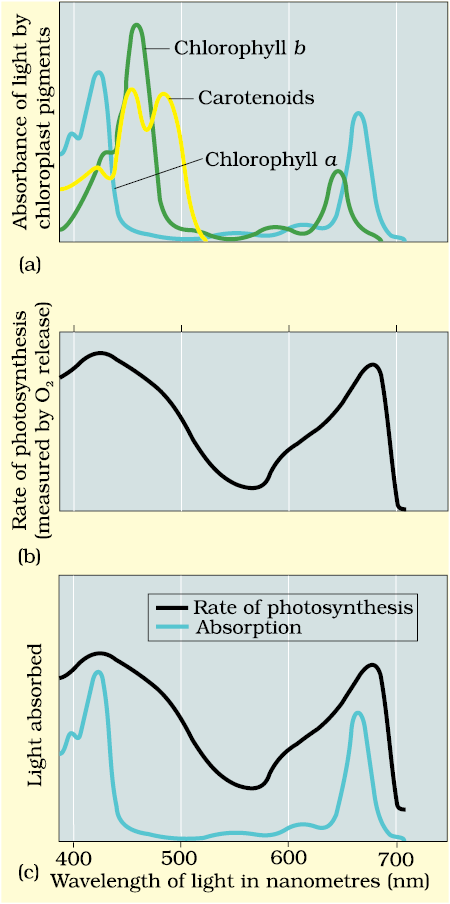Looking at plants have you ever wondered why and how there are so many shades of green in their leaves – even in the same plant? We can look for an answer to this question by trying to separate the leaf pigments of any green plant through paper chromatography. A chromatographic separation of the leaf pigments shows that the colour that we see in leaves is not due to a single pigment but due to four pigments: Chlorophyll a (bright or blue green in the chromatogram), chlorophyll b (yellow green), xanthophylls (yellow) and carotenoids (yellow to yellow-orange). Let us now see what roles various pigments play in photosynthesis.
Pigments are substances that have an ability to absorb light, at specific wavelengths. Can you guess which is the most abundant plant pigment in the world? Let us study the graph showing the ability of chlorophyll a pigment to absorb lights of different wavelengths (Figure 13.3 a). Of course, you are familiar with the wavelength of the visible spectrum of light as well as the VIBGYOR.
From Figure 13.3a can you determine the wavelength (colour of light) at which chlorophyll a shows the maximum absorption? Does it show another absorption peak at any other wavelengths too? If yes, which one?

Figure 13.3a Graph showing the absorption spectrum of chlorophyll a, b and the carotenoids
Figure 13.3b Graph showing action spectrum of photosynthesis
Figure 13.3c Graph showing action spectrum of photosynthesis superimposed on absorption spectrum of chlorophyll a
Now look at Figure 13.3b showing the wavelengths at which maximum photosynthesis occurs in a plant. Can you see that the wavelengths at which there is maximum absorption by chlorophyll a, i.e., in the blue and the red regions, also shows higher rate of photosynthesis. Hence, we can conclude that chlorophyll a is the chief pigment associated with photosynthesis. But by looking at Figure 13.3c can you say that there is a complete one-to-one overlap between the absorption spectrum of chlorophyll a and the action spectrum of photosynthesis?
These graphs, together, show that most of the photosynthesis takes place in the blue and red regions of the spectrum; some photosynthesis does take place at the other wavelengths of the visible spectrum. Let us see how this happens. Though chlorophyll is the major pigment responsible for trapping light, other thylakoid pigments like chlorophyll b, xanthophylls and carotenoids, which are called accessory pigments, also absorb light and transfer the energy to chlorophyll a. Indeed, they not only enable a wider range of wavelength of incoming light to be utilised for photosyntesis but also protect chlorophyll a from photo-oxidation.